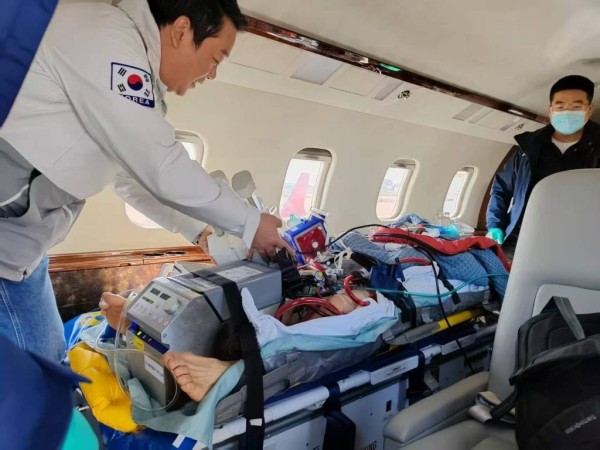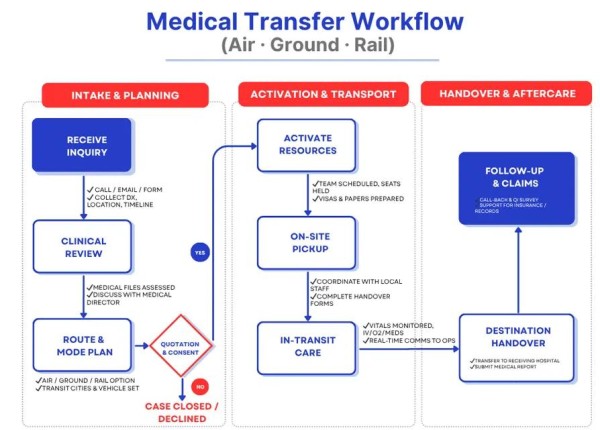How Modern Technology Is Improving Patient Air Transfer Safety
China, 5th Nov 2025 – Shenzhen, China – Medical transport is changing fast. New tools are making flights safer, smoother, and easier to coordinate. Patients now travel farther with fewer risks. Data links, smarter devices, and clearer workflows help teams act early and avoid errors. But problems remain. Prices are high. Permits can take time. Reimbursement is often unclear. This report looks at what is working, what still hurts, and how TKP Medical Assistance uses technology to close the gap.

- The Industry Pain Points
Air transfers save lives, yet the system is hard to navigate. Families struggle to compare air medical transport vs ground ambulance. Cross-border rules vary by airport and country. Insurance for patient air transfer may require preauthorization that slows decisions. Night flying, cabin pressure, and tight cabins raise clinical risk. Many regions lack shared standards for patient transfer services. These gaps lead to hesitation, extra cost, and dangerous delays.
Five Tech Shifts Lifting Safety
1) Real-time monitoring with smart alerts.
ICU monitors stream vital signs to tablets on board. Clinicians see oxygen levels, blood pressure, and ventilator waveforms in one glance. Algorithms flag silent trends before they turn into crises. Fewer false alarms mean faster action when it matters.
2) Altitude-ready ventilation and circulatory support.
Modern ventilators auto-compensate for pressure changes. Battery systems extend run time between power sources. For severe cases, ECMO and IABP stabilize gas exchange and perfusion. Safe power switching protects devices during taxi, takeoff, and landing.
3) Integrated routing across air, rail, and road.
Digital dispatch compares aircraft range, weather, and ground ETA. Mixed-mode plans reduce time at altitude and avoid turbulence when possible. This approach supports non-emergency medical transport by air, where shorter segments lower stress for fragile patients.

4) Secure data sharing and tele-ICU oversight.
Encrypted platforms transmit records, imaging, and lab results to the receiving hospital. Remote specialists advise flight crews in real time. Shared checklists keep teams aligned from bedside pickup to handover.
5) Predictive logistics and readiness checks.
Apps track equipment health, battery status, oxygen planning, and drug stock. Digital manifests speed airline approvals for stretchers and Private medical flights. Fewer surprises. Faster wheels-up.
- Where Costs and Coverage Still Hurt
Safety advances do not always reduce the bill. Dedicated aircraft are expensive to operate. Short-notice permits add fees. Insurance for patient air transfer can exclude “non-medical necessity” or out-of-network teams. Families sometimes face surprise costs when mode of transport is disputed. Hospitals also struggle to compare air medical transport vs ground ambulance when beds, weather, and distance change each hour. The market needs clearer price baselines, outcome data, and shared definitions of necessity.
TKP Medical Assistance: Tech That Shows Up in Care
TKP Medical Assistance is a pioneer in cross-border transfers and air ambulance missions across China and the Greater Bay Area. Founded in 2001, the company reports more than 10,000 missions. Shenzhen is the hub, with six branch offices across China. Partners in Hong Kong, Southeast Asia, and Europe support 24/7 response. TKP coordinates end-to-end patient transfer services with one point of contact.

How TKP turns technology into results:
• ICU-equipped air ambulances. Ventilators, syringe pumps, defibrillators, and full monitoring are calibrated for altitude. Intensive care doctors and flight-trained nurses manage sedation, ventilation, and hemodynamics throughout the mission.
• ECMO and IABP capability. Redundant power and batteries secure uninterrupted flows when switching from ground to aircraft systems.
• Commercial stretcher programs. With airline approval, TKP fits stretcher kits on scheduled flights. A safe, economical option for stable patients who do not need a dedicated jet.
• Rail-integrated transfers. High-speed rail segments reduce cabin pressure exposure and shorten flight time. Ambulance teams meet the train at both ends to keep monitoring continuous.
• Digital coordination platform. Case managers, clinicians, and partners share permits, checklists, and timelines in real time. This speeds airport clearance for stretchers and Private medical flights.
• Insurer and corporate support. Preauthorization files, medical summaries, and cost breakdowns reduce disputes and speed reimbursement for insurance for patient air transfer.
Case Snapshot: Xiamen → Seoul (ECMO + IABP)
In March 2025, TKP moved a patient with severe pulmonary infection from Xiamen to Seoul. The mission required ECMO and IABP. Specialist doctors and ICU nurses handled the case. Mobile power units protected circuits during ground-to-air transitions. At the tarmac, the team executed a zero-interruption handoff to aircraft power. In flight, clinicians tracked ECMO flow, anticoagulation, and ventilation parameters. The outcome showed how tight protocols, redundancy, and training reduce risk when every minute counts.

- Process That Bakes In Safety
TKP follows a nine-step activation flow:
(1)Intake: capture clinical data, timelines, and payor details.
(2)Clinical review: define escort level, devices, and medications.
(3)Route and mode: compare air medical transport vs ground ambulance and rail options.
(4)Transparent quote: align cost, authorization, and consent.
(5)Resource activation: test equipment and confirm backups.
(6)Bedside pickup: stabilize and complete safety checks.
(7)In-transit care: continuous monitoring and treatment.
(8)Destination handover: transfer reports and responsibility.
(9)Follow-up and claims: close the loop and support reimbursement.

Each phase uses digital checklists and timestamped notes. Escalation paths keep decisions moving, even across borders and time zones.
- What It Means for Stakeholders?
For patients and families, better tools create calmer journeys and fewer complications. For hospitals, predictable handovers free ICU capacity faster. For insurers, high-fidelity documentation supports necessity and reduces disputes. Clearer pathways for non-emergency medical transport by air also lower the risk of last-minute plan changes.
The Road Ahead
The sector still needs shared safety metrics: time-to-handover, in-transit complications, readmission rates, and patient-reported outcomes. Price transparency will help families choose the right mode and provider. Wider use of commercial stretcher programs can cut costs without losing safety. Closer cooperation between airlines, airports, and medical teams will streamline clearances for Private medical flights.
TKP Medical Assistance is building toward that future. Integrated air, land, and rail operations, ICU-grade capabilities, and insurer-ready documentation set a higher bar for patient transfer services. The mission is clear: move patients safely, keep care continuous, avoid preventable delays, and use technology to make every mile safer than the last.
For tailored planning and 24/7 support: info@tkpma.cn
Company Details
Organization: TKP Assistance
Contact Person: Yuanzheng Entrepreneurship Building, Nanshan District, Shenzhen, Guangdong Province, China
Website: https://www.tkp-assistance.net/
Email: Send Email
Contact Number: +8675583980108
Country: China
Release Id: 05112536555
